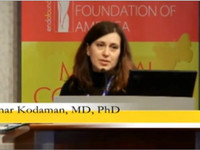Asgerally T. Fazleabas. PhD:
Good morning everybody, and Tamer, thank you and the Endometriosis Foundation for this invitation. I am really, really glad to be here. What I would like to do in the next 20 minutes or so is to give you an overview of the work we have been doing using a model system to try to understand this enigmatic disease. By way of disclosure, as Heather has already pointed out, I have several components but nothing I am going to talk about has any relevance to any of the work I do with any of these companies.
What I would like to do with you today is first give you a brief description of the model that we use and speak to you about the potential mechanisms of how we can utilize this model to understand the basic etiology of the disease, keeping in mind that the model systems are model systems. The animal model that we use, as I will describe to you is a non-human primate, pretty much focuses on the impact of menstrual tissue creating peritoneal disease. It does not go into the extensive disease that you are going to hear about when the surgeons speak to you later this afternoon. We are looking at the very initiation of the disease using menstrual tissue, trying to mimic Sampson’s hypothesis of retrograde menstruation, and looking to see what the effects are of this early impact on both ectopic development of lesions, as well as the eutopic endometrium as it impacts fertility. The second point that I am going to talk to you about is the very, very early insult that these lesions impact on the endometrium and as Tamer mentioned one of the issues really is the issue of infertility that is associated with these patients. You have pain and infertility and one of the most difficult things to really study in any way in a human population is why implantation does fail in some of these situations. We can utilize this model to try to understand the very intricate dialogue that goes on very early during the establishment of pregnancy, and ask what is the miscommunication between the embryo and the endometrium that actually could have an impact on the ability of women with this disease to get pregnant.
Why do we use this model? We use the baboon as a non-human primate surrogate model for this disease. First and foremost this animal model is a menstruating species so they get spontaneous disease. That in itself makes a unique model compared to any of the rodent models, and things like that, where you have to artificially induce the disease. As a result, what we can do, is since these animals get spontaneous disease, and generally in captivity does increase, but in general 8 to 10 percent of animals caught in the wild if you do a random laparoscopy on them, 8 to 10 percent of these animals will have the disease. And our ability to be able to induce the disease now allows us to really compare what the early events of this disease are compared to spontaneous disease. As most of you know by the time a woman is diagnosed with endometriosis it is 8 to 11 years downstream, and as a result you do not really know what happened in the early events to try to manipulate whether you want to do it from a prevention standpoint, whether you want to do it from a therapeutic standpoint, you really have no way of intervening. This is sort of where our focus is, is in trying to understand the basic etiology as it relates to intervention, prevention and also to be able to come up with biomarkers for early diagnosis. That gives us a major advantage with this species.
The second point is that our ability to induce the disease, we know exactly from day one, and we know these animals do not have disease, we now create the disease in these animals and we can actually understand the direct impact of this disease in terms of the questions that we would like to ask in terms of ectopic lesion development as well as the insult on the eutopic endometrium. The other advantages we have obviously are these are strong animals, they live for a long time, so as a result, once we induce the disease they will maintain the disease for life. As a result we can do long-term invasive studies and because of its close phylogenetic relationship as I will show you, we can directly compare work in the human with work in our model to ask how relevant are our questions, and our results to what is happening in the human situation. I will show you some examples of that.
Most importantly again, we need treatment modalities. We are really, really limited to the treatment of these patients. Again, as new drugs come down the pike or personalized medicine where we can utilize Geneoray technology to try identify various compounds that might have usefulness, we can utilize this animal to ask the question whether these compounds and drugs that are already on the market, depending on what their targets are, whether they might have some opportunity to be utilized for this disease.
First and foremost how do we create the disease in these animals? Essentially what we do is – the size of this animal also allows us to use all human instrumentation. We do not have to modify any of our laparoscopic equipment to be able to assess these animals. What we first do is because they do have spontaneous disease we essentially first do a laparoscopy and make sure that these animals do not have spontaneous disease. Then on two consecutive menstrual cycles what we do is we use unilaminar pipels, aspirate menstrual fluid and menstrual tissue, we are not doing any currating just whatever is in the uterine cavity, and essentially deposit it in the peritoneal cavity. We do this on two consecutive menses and as a result, I will show you, by the second mense you get a large cohort of red lesions developing in these animals. Then what we do is every three months we can go in surgically and manipulate the animal, first get an idea of how the disease is progressing but more importantly we can sample both ectopic and eutopic tissue at each of these time points and then ask what happens during disease progression. The other thing is if you want to keep these animals around after 15 months, we limit ourselves to 15 months mostly because of the expense of keeping these animals around, but if you keep these animals in situations where we can for long term they will retain the disease basically for the rest of their lives.
When we have done these, and these are laparoscopic images as you can see these are as early as three and six months into the disease, you can see the very nice blue lesions, the extensive vascularization around the lesions, they look very similar to what you would see in a human situation. This is obviously much more extensive disease but just to give you an example they are very, very reminiscent of what you would see through a laparoscope as far as the human is concerned. Having established this disease and seeing what happens during the progression we asked two specific questions. One, what happens, what are the early events that surround the development of these lesions, what genes, what proteins, what molecules are involved in this process? And second, how early is this insult impacting other eutopic endometrium to really change the genetic component of that endometrium so it no longer is capable of sustaining a pregnancy?
I am going to summarize a lot of this data, this is over the last 15 years, and I am going to show you summaries of all of our data and not get involved with a lot of the genes and I will just really point out specific components in terms of the overall concept on how we are looking at this disease. What our work has basically suggested is that when we inoculated these animals and then we take menstrual tissue from these animals after they have been inoculated, very quickly we see that the menstrual component of these animals are already changed. If you take menstrual tissue and you compare it with an animal without disease, the menstrual tissue in these animals already have genes that are associated with both adhesion and invasion and vascularization. Already that menstrual tissue has changed its phenotype. What is does is that it can attach to the peritoneum in the early phases of the disease and essentially activate the estrogen component where the disease is dependent on estrogen, and activate genes that can also suppress progesterone. The concept of progesterone resistance is becoming more and more important as far as this disease is concerned.
Together with this, what we also find in working with Dharani Hapangama at the University of Liverpool that associated with these changes we also see the change in expression of metastatic inducer protein. So proteins that might be involved in cancer are also turning out to be expressed in these early lesions. And secondly what we see as we go on as these lesions develop and change, and I will show you in the next slide how they change in color and texture, you now begin to see that these tissues now express their most invasive characteristics. They change their ability to be able to invade and as a result, this enhances, and continuously enhances cell invasion because this is a continuous process where these lesions continuously develop in these animals after we induced the disease. Again, this is also associated with proliferative anti-apoptotic genes because these prevent these tissues from being rejected and also they develop _____ fibers, which are again becoming very interesting in terms of what it might have implications with regard to pain.
Then when we went back to look and see what happens with lesion turnover. Now we can look at these lesions directly every single time and really make a map of what might be happening. You can see here right by the second mense we know how many lesions there are by the laparoscope. Then if you look to see what happens during the frequency of the number of new lesions that form all throughout our profile you can see constantly there are new lesions that are beginning to appear. So, even those these animals have only been inoculated twice with menstrual tissue the continuous retrograde menstruation continuously starts ceding the peritoneum that has already undergone the insult to develop more and more new lesions. If you then look at the characteristics of these lesions you can see in the early phases of the disease the very characteristic red lesions that are highly vascularized and forming. By about six months in the disease process you see this mixed component that is always reported in the literature and that surgeons will talk to you about that you see pretty much number of red lesions starting to develop but these lesions begin to transform and become the predominantly the chocolate and the blue chocolate lesions. Essentially what we are seeing is that every time point that we look at there are new lesions. This is dependent on menstruation because if you over-activate these animals and just put them on strict estrogen treatment, where they do not cycle anymore, we do not get the development of new lesions. This retrograde menstruation or the receding of menstrual tissue appears to be very critical. We do not see any significant variation in the number of new lesions that are formed, and that is constant, and these keep __________ and persist all the way out to 15 months and I said if you keep these animals around they will continue to have these lesions for the rest of their lives.
Based on these lesions the next question we asked is as we do these experiments in parallel, and since we essentially want to also look at the effects of what happens on the eutopic endometrium, there have been several ideas and theories proposed in terms of what might be causing the infertility. We focused predominantly on what might be happening in the eutopic endometrium. Essentially the anomalies that had been suggested to be associated with endometriosis are an anomaly inflammation and this is related to the alterations in estradiol responsiveness of this tissue during the mid-secretory phase and the development of resistance to progesterone. This has essentially been a very interesting topic, how does this tissue in the mid-secretory phase no longer respond to progesterone, because that is so critical for the establishment of pregnancy? I am going to show you some information of how we think this might be happening and why progesterone resistance occurs.
Our question here is, in women with the disease there is always the discussion that they already have an inherently defective endometrium. All women have retrograde menstruation but only 10 percent of the women essentially have disease if you look at the statistics. So, do these women have an inherent defect, or is the very early development of these lesions already creating an insult on the endometrium to make it defective? You cannot ask those questions obviously in a human because by the time the woman comes to you she has already had the disease for an extended period of time. So we just asked that question. What happens when we do that initial insult? What we were able to show, and do not worry about all these genes, I am just going to take you through really the overall concept of this; so what we were able to show was that first and foremost taking this tissue at a very, very specific time point, we take the tissue between eight and ten days post-ovulation the purity of implantation window at the time that the endometrium is responsive to the embryo, and if you then look to see what happens during this time ______ disease progression what we find very early is that the progesterone regulated genes are not altered. They are what you would expect to see in a control animal. What we begin to see is that the endometrium first is no longer responsible for progesterone in the sense of the express estrogen regulated proteins and these are the two of the proteins that involved in invasion and angiogenesis and here is a protein that is involved in also suppressing progesterone function., but more importantly inducing epigenetic changes by increasing methyltransferases. The early events you see right here are more estrogenic and the endometrium at the ultrastructural level also looks more estrogenic even though the tissue was taken in the mid-secretory phase. Then we go through a transition phase somewhere between six and nine months where all of these genes are beginning to be altered, particularly those associated with the progesterone receptor. Later in the disease is what you see is what you will always find in women with the disease in the terms of the genes that the progesterone receptor is altered, down-regulated and chaperone proteins and downstream proteins associated with these genes are also altered. The HOX genes have also been playing a major role now with the genetic analysis also suggesting that the HOX genes might be involved in some of the regions that are involved with endometriosis.
But I just want to show you a couple of examples, for example if FKBP-52, which is a chaperone protein that is involved with the function of the progesterone receptor. In seeing these, and these are changes that have already been documented in women with the disease, how relevant is our model with regard to what happens with women with the disease? Here is an example of tissue taken from women now with endometriosis who had outcomes, either they got pregnant or did not get pregnant with regard to IVF with endometriosis. You can see that if FKBP-52, which is a gene that is important for transporting the progesterone receptor to the nucleus is essentially, significantly down-regulated in these women and also not only is the protein down-regulated but the messenger RNA for this gene is also down-regulated. We also looked at his cohort of patients in terms of how it might affect, and again this is a lot of data, but I just want to take you through in a way of how we tried to understand this. If you now look at the cohort of woman comparing our IVF metrics analysis in the baboon to the women with the disease, and what you can see is just focused particularly on this line and this panel right here, what we find is that in these women that could not get pregnant with IVF that their whole menthylation profile and their expression profile of genes in the eutopic endometrium are completely altered compared to their control cohorts and women that were able to get pregnant. These are whole number of genes this is what we are trying to focus on to see if these signatures that the methylation along with expression could give us signature genes that could be really focused on to try to see whether we can predict whether the women will benefit from laparoscopic surgery, and then the option to get pregnant versus those that perhaps need early intervention to be able to get pregnant.
The second question now is the one of what happens when the embryo comes along. Several years ago we created a model where we can actually mimic the early endocrine events within the uterus. What we do is infuse choriongonadotropin during this period of window of implantation and ask the question now in this endometrium that has already been insulted by the presence of these lesions, what happens when you now create an environment which is associated with the embryo and endometrium? What we find is that normally in response to choriongonadotropin all of the major cell types in the endometrium, the luminal epithelium, the stromal fibroblast and the glandular epithelium undergo a very, very profound change, in addition to a large number of genes that I am not going to talk to you about but it has been published recently. What we find is that when these animals have endometriosis all of these responses, this is the change in the tight junctions that are important for trophoblast migration, the transformation of the stromal cells, which are critical for the destabilization response and the induction of genes that might be involved with immune modulation of the uterus to maintain the pregnancy. They are all altered in response to endometriosis. So now what you have is a progesterone resistant endometrium that can no longer respond to the embryonic signal.
Basically that is my summary slide that suggests to us that the presence of these lesions very, very early are creating both an epigenetic change by up-regulating genes that are involved with methyltransferases and also altering the steroid hormone milieu within the endometrium, both acting in concert to essentially have a very dramatic effect on the endometrium. At the same time these are also altering the actual components of the menstrual tissue, which then allows for the receding to occur and these lesions to continue to develop. It is a very dramatic effect, a huge insult that is involved with the process and as a result both the eutopic and the ectopic endometrium are now affected and they talk to one another in a very direct manner.
With that, my time is up, but let me go to the most important slide and for some reason again this is not showing, but this is my acknowledgement slide of the people that have really done all the work, which is really the most important slide – ah, excellent. Really these are the number of people I have been very fortunate, I was at the University of Illinois before I moved to Michigan State University about a year and a half ago. This is the group that worked with me for many years, my post-docs that worked with me, my new group at Michigan State that continue to work on these. Then I have been very, very fortunate to have had some wonderful collaborators over the years that have really contributed to a number of these things as you can imagine, working with non-human primates is not an easy task and you need a lot of collaborators to be able to ask all of the relevant questions.
So thank you very much again.










